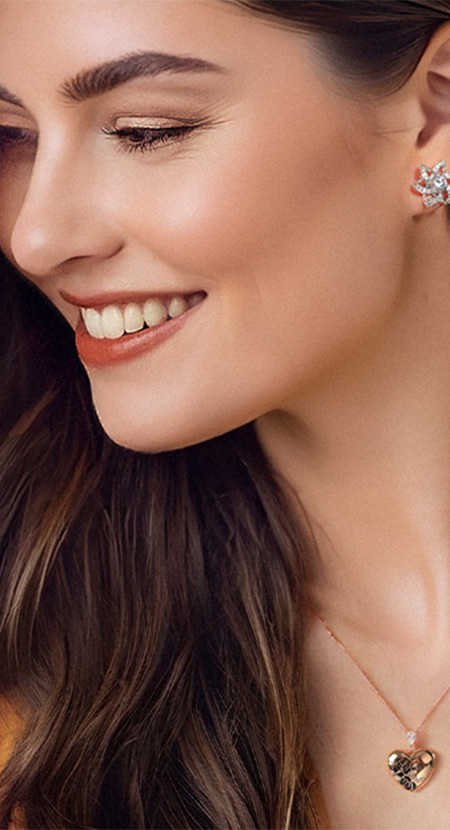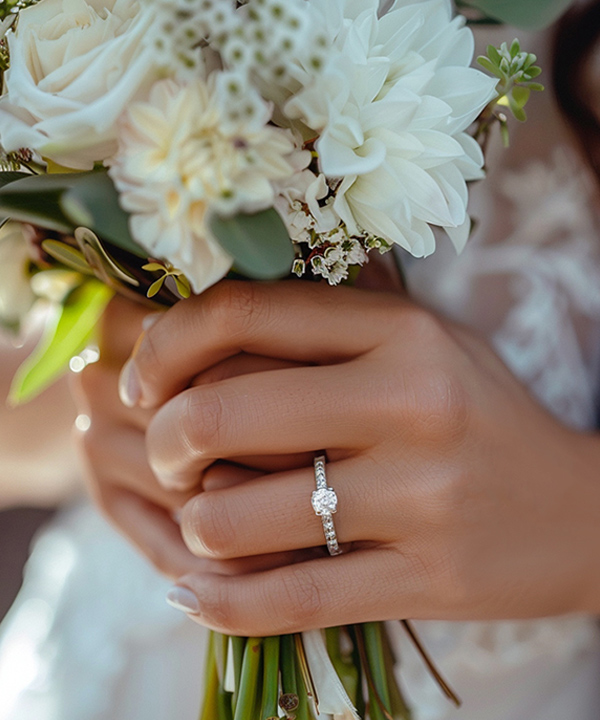Moissanite vs Diamond: 4 Differences to Know Before You Buy

Moissanite and diamonds may both be colorless, but that’s where the similarities stop. When set side by side, you may start to notice their differences. Moissanite engagement rings and wedding jewelry are hot items today and for good reason. But how does it compare with diamond engagement rings? Let’s find out.
#1: Origin
Moissanite
Natural moissanite is extremely rare. It’s so rare, you can expect all moissanite jewelry to be lab-made today. This diamond alternative was discovered in a crater by a French scientist named Henri Moissan.
Moissan initially thought he had found a diamond within a meteorite in a crater in Arizona in 1893. Henri Moissan dedicated many years of his career to attempting to create diamonds using tiny stone fragments from meteorites.

Instead of a tiny diamond, Dr. Moissan discovered silicon carbide and named it after himself, calling it moissanite. It may also be nicknamed the Space Diamond or Stardust because of its otherworldly origins outside our atmosphere.
Can you imagine owning an engagement ring from space? While natural moissanite is non-existent, you can have your very own Space Diamond from our wide selection of brilliant moissanite rings.
The first successful synthesization of moissanite was done by Charles and Colvard, often called the Father of Moissanite. However, many retailers carry moissanite gemstones as a diamond alternative. The moissanite we see in jewelry stores today is all lab-grown. Some gemstones have both a lab-grown and natural form, but moissanite is not labeled as such.

Diamond
Natural diamonds are formed within the earth over billions of years. There are more natural diamonds in the world than there are natural moissanite. Diamonds are made of pure carbon, the ingredients are the same as our common coal, pencil lead, and sugar ingredients. Within the Earth, pure carbon particles undergo high temperatures and immense pressure over an extended period, eventually crystallizing into diamonds.
Since diamonds were discovered in India 3,000 years ago, diamond mining has become one of the important activities for jewelers. Today, over 30 countries have diamond resources with an annual output of about 100 million carats.

The annual output of diamonds is about 100 million carats, while only 4 million carats are processed into diamonds. According to a rough estimate, about 250 tons of ore would need to be mined to get 1 carat of a polished diamond.
Because of the high profits of diamonds, some diamonds are mined in war zones and sold to finance an insurgency, an invading army's war efforts, terrorism, or a warlord's activity. These are blood diamonds (conflict diamonds, brown diamonds, hot diamonds, or red diamonds). Everyone has to reject blood diamonds for their ethical origins.

#2: Brilliance
Moissanite
At first glance, you might think a moissanite engagement ring is a diamond. But when comparing brilliance and light performance, you’ll notice the difference pretty quickly.
If you have a premium or super premium quality moissanite, it will sparkle more. However, moissanite in its entirety is compared to the light performance of a disco ball. Some love the flashy rainbow light that emits from the stone while others find it overwhelming.

But if you’re looking for more bling in your engagement ring, a moissanite engagement ring like this nature style moissanite engagement ring in the diamond shape of your choice! This moissanite ring setting style is a favorite of many and will sparkle more than a diamond engagement ring.
Diamond
Diamonds have more of a subtle brilliance when compared with moissanite. When lights enter a well-cut diamond, it reflects a balance of rainbow light and white light back out.
It can be difficult to imagine the sparkle of a diamond vs the sparkle of moissanite wedding jewelry. Both are beautiful, so it's your turn to decide which sparkle meets your taste.
If you love the fire and brilliance of a diamond, a brilliant cut engagement rings will be an excellent choice. Brilliant cut shapes like round diamonds, princess cut, and pear cut diamonds are all examples. They are cut with many facets to give a glittering effect.
Diamond shapes like emerald cut, asscher cut, and baguette cut diamonds are all step-cut. They still sparkle but with long dramatic flashes of light, rather than the glitter look.
#3 Durability
Moissanite
Moissanite hits a 9.5 on the Mineral Scale of Hardness, also known as the Moh scale. The Moh scale rating of a mineral lets you know its resistance to scratching. The dust in the air is made of microscopic minerals like quartz.
If you intend to wear your wedding jewelry daily, opt for a gemstone that can withstand scratches from airborne dust. Softer gemstones with a lower Moh scale rating will not hold up as well for an engagement ring or wedding jewelry you’ll wear every day.
Moissanite has the second-highest mineral hardness. A sapphire hits a 9 on the Moh scale and is recommended for everyday wear. The same is true for a moissanite.
One of the biggest concerns about buying a diamond engagement ring is the risk of it chipping. Diamonds have a high hardness but are brittle. They can break if dropped hard enough. Not with a moissanite engagement ring. They have excellent hardness and tenacity. Therefore, moissanite is the perfect center stone for a solitaire engagement ring.
Diamond
A diamond is the hardest mineral in the world. It reaches a 10 on the Mohs scale. Only a diamond is capable of scratching a diamond. Though diamonds have an excellent resistance to scratching, they are still vulnerable.
Many faceted gemstones have cleavage that may contribute to their breakability. A lot of people confuse hardness with overall durability. There are a few different factors that contribute to the overall durability of a stone. Most faceted gemstones have a possibility of chipping or breaking if struck hard enough.
Contract to a moissanite engagement ring, a diamond engagement ring has an increased chance of chipping if struck hard. Does it mean it absolutely will break? No. But you’d be more likely to see the diamond chip than the moissanite.

#4 Price
Moissanite
Moissanite stones are graded much differently than diamonds. They will often come as standard, premium, and super premium moissanite. Not every retailer will categorize them.
On average, the super-premium moissanite engagement rings are meant to be the highest quality cut and color for moissanite wedding jewelry. Moissanite engagement rings are often much larger, which doesn’t impact the price nearly as much as a diamond.
Moissanite gemstones are not the least expensive diamond alternative in the jewelry industry. White sapphire, white topaz, white zircon, and cubic zirconia usually make a more affordable engagement ring than a high-quality moissanite engagement ring. However, natural white sapphires can compete with the price of a moissanite.
Moissanite is also the most popular diamond alternative in the industry today. Though it may not be the most expensive diamond engagement ring alternative, moissanite is the best in durability and price.
If you’re looking for more bang for your buck, you can find lots of excellent choices for engagement rings under $1000 with super premium quality moissanite inlaid.
Diamond
Though it may seem that diamonds aren’t rare because they’re littered all over the place in jewelry cases, that’s not quite the case. Natural diamonds graded with high clarity and colorless diamond grades can be expensive, especially if the carat weight is high too.
The price and value of a diamond are affected by many different factors. The biggest ones are the cut, clarity, color, and carat weight. The higher the diamond grades are, the more expensive they can be. That’s why it’s good to choose a balance of grades and prioritize what’s most important to you in your diamond.

The other big factor is the origin of the diamond. Lab-created diamonds are much less expensive than natural diamonds of the same quality. But they are real diamonds, created in a lab instead of the ground. They have the same durability and brilliance graded in the same way.
Lab-grown diamonds typically do not command the same price or value as natural diamonds. Lab diamonds can cost 20-60% less than their natural counterparts. Due to the price volatility, lab diamonds often lack significant resale value at traditional jewelry stores.
Summary
At present, moissanites are preferred to diamonds as they have more advantages in price, durability, and brilliance, they also have less impact on the environment. If you loved a custom moissanite engagement ring, VANCARO only offers colorless with Excellent cut and VVS1 and above clarity grade moissanite, it would be a fantastic choice!

Find Your Perfect Jewelry Quickly
Free One-on-One Jewelry Expert Consultation
Thank you!
Your Information has been successfully submitted. Our expert will contact you soon. FYI, please check your inbox for the coupon we sent via email.
OK






